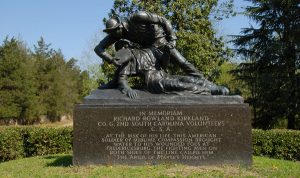A Mainer’s “Richard Kirkland” moment at Second Fredericksburg
Near the Sunken Road at Fredericksburg stands the famous monument depicting Confederate Sgt. Richard Rowland Kirkland, a South Carolinian who left his position behind the Stone Wall on Saturday, December 13, 1862 to bring “water to his wounded foes” lying on the slopes below the wall.

The engraving on the monument’s base indicates that “both sides of the line called him ‘the angel of Marye’s Heights.’”
A similar tale involving a 6th Maine soldier emerged from late in the battle of Second Fredericksburg (fought May 3-4, 1863. if you include VI Corps’ fighting withdrawal to the Rappahannock River). Few people apparently witnessed the Mainer’s heroism, but a Confederate general did, and someone well up the Army of Northern Virginia’s chain of command met the Yankee.
Standing 6-2, Elbridge T. Crockett was an unmarried, 21-year-old farmer living in Guilford in Piscataquis County when he enlisted as a private in Co. A, 6th Maine Infantry Regiment, on July 1, 1861. He had blue eyes, light (i.e., blonde) hair, and a light complexion.
The regiment and Crockett mustered on July 14, 1861, headed for Washington, D.C., and fought on the Peninsula. At Fredericksburg on Sunday, May 3, 1863, the 6th Maine Infantry and other Union troops attacked Confederate soldiers defending Marye’s Heights, the high ground just outside the city.
Advancing with the cold steel, the Mainers, the 5th Wisconsin Infantry lads, and other Yankees overran the Stone Wall, the Sunken Road, and the artillery atop the heights. Later, after pushing west and losing a fight at Salem Church, VI Corps withdrew into a perimeter anchored on both flanks by the Rappahannock River.
Crockett’s Kirkland-style moment begins with Brig. Gen. Cadmus M. Wilcox, commanding an all-Alabama brigade in the division led by Maj. Gen. Richard H. Anderson. On Monday evening, May 4, Wilcox participated in the hard push against VI Corps’ right flank, where the 6th Maine Infantry fought.
The regiment’s adjutant, 1st Lt. Charles A. Clark, ordered Crockett to escort a captured Confederate officer “over the bluff, down to the water’s edge … and turn his prisoner in to any [Union] force he might find there.” In the darkness, the Johnny told Crockett “it would be impossible to descend the bluff[,] it was so steep,” and the two men should work their way along “the edge of the bluff.”
Crockett concurred, and “in two or three minutes found himself” surrounded by other Confederates, Clark said. The jig was up; Crockett was a prisoner.
Sometime afterwards Crockett “observed a wounded rebel lying on the ground[,] exposed to the fire [bullet or artillery] and begging for water,” the press later reported. “He [Crockett] took him upon his back, carried him to a place of safety and brought him water in his canteen.”
The incident must have occurred the next day, because VI Corps had withdrawn across the Rappahannock by dawn or so on May 5. Wilcox “observed the action” and afterwards presented Crockett to Robert E. Lee. Wilcox apparently explained what the Yankee prisoner had done.
Lee asked Crockett “where he belonged,” and Crockett identified his regiment (and being a Mainer, probably his hometown, too).
“The Maine troops are the best troops in your army,” Lee replied (italicized in the original).
He authorized “the young hero [Crockett] a pass on the railroad to Richmond, and in a few days he was exchanged,” the press reported.
Is this story true? Replacing the Capt. Sewall C. Gray shot dead as the 6th Maine charged Marye’s Heights, Capt. Alexander B. Sumner of Co. A noted (via Orderly Sgt. Ira P. Wing) on November 1, 1863 that Crockett had been a “pris.[oner] at Fredericksb’g” and was then “paroled.”
His comrades knew at least that much of the story, and Crockett apparently told them about his encounters with Wilcox and Lee. He was not present at Gettysburg due to his parole, but he survived the next year to return to Maine with “the relics of this glorious [6th Maine] regiment” in late July 1864.
“We are glad to learn [Crockett] returned home with his company safe and sound,” the press stated.
Elbridge T. Crockett mustered out on August 15, 1864.
Sources: Elbridge T. Crockett Soldier’s File, Maine State Archives; The Sixth Maine Regiment, Portland Daily Press, July 30, 1864; Charles A. Clark, Campaigning With the Sixth Maine (Des Moines, Iowa, 1897), 36; Annual Report of the Adjutant General of the State of Maine 1863 (Augusta, ME, 1863), Appendix D, 220
Great story of an unsung hero. Even while captured, his sense of right and wrong was strong. Thanks. This second battle of Fredericksburg resulted in the famous picture of “Confederate Dead at Fredericksburg,” not the first.
Thank you, Henry. I have wondered how fast the photographer who “shot” the “Confederate Dead at Fredericksburg” cleared out when the Confederates reoccupied the city.
My great-great grandfather, the herein mentioned Charles Clark, was awarded his Medal of Honor for the actions he took to save the regiment as they were surrounded by Confederate forces there, requiring them to move down that “precipitous bluff” and quietly proceed along the river with the Confederate forces above them.